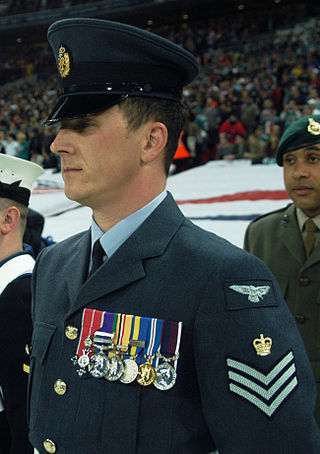Lance corporal is a military rank, used by many English-speaking armed forces worldwide, and also by some police forces and other uniformed organisations. It is below the rank of corporal.
Flying officer is a junior officer rank used by some air forces, with origins from the Royal Air Force. The rank is used by air forces of many countries that have historical British influence.
Squadron leader is a senior officer rank used by some air forces, with origins from the Royal Air Force. The rank is used by air forces of many countries that have historical British influence.
Wing commander is a senior officer rank used by some air forces, with origins from the Royal Air Force. The rank is used by air forces of many countries that have historical British influence.
Group captain is a senior officer rank used by some air forces, with origins from the Royal Air Force. The rank is used by air forces of many countries that have historical British influence.
Air commodore is a air officer rank used by some air forces, with origins from the Royal Air Force. The rank is also used by the air forces of many countries which have historical British influence and it is sometimes used as the English translation of an equivalent rank in countries which have a non-English air force-specific rank structure.
Air vice-marshal is a air officer rank used by some air forces, with origins from the Royal Air Force. The rank is also used by the air forces of many countries which have historical British influence and it is sometimes used as the English translation of an equivalent rank in countries which have a non-English air force-specific rank structure.
Air marshal is an air-officer rank used by some air forces, with origins from the Royal Air Force. The rank is used by the air forces of many countries which have historical British influence, including many Commonwealth nations. The rank is usually equivalent to a vice admiral or a lieutenant general.
Air chief marshal is a high-ranking air officer rank used by some air forces, with origins from the Royal Air Force. The rank is used by air forces of many countries that have historical British influence. An air chief marshal is equivalent to an Admiral in a navy or a full general in an army or other nations' air forces.
Flight lieutenant is a junior officer rank used by some air forces, with origins from the Royal Air Force. The rank originated in the Royal Naval Air Service (RNAS) in 1914. It fell into abeyance when the RNAS merged with the Royal Flying Corps during the First World War but was revived in 1919 in the post-war RAF. The rank is used by air forces of many countries that have historical British influence.

Flight sergeant is a senior non-commissioned rank in the Royal Air Force and several other air forces which have adopted all or part of the RAF rank structure. It is equivalent to a staff sergeant or colour sergeant in the British Army, a colour sergeant in the Royal Marines, and a chief petty officer in the Royal Navy, and has a NATO rank code of OR-7. In the RAF, flight sergeant ranks above chief technician and below warrant officer.
Junior technician is a junior non-commissioned rank in the Royal Air Force, the Pakistan Air Force and the Royal Danish Air Force. In the RAF it ranks equivalent to senior aircraftman technician, equivalent to senior aircraftman (AS1) and below corporal and has a NATO rank code of OR-2. Since 2005, the RAF has ceased promoting to and therefore phasing out of this rank, to be replaced by AS1(T).

Senior aircraftman (SAC) or senior aircraftwoman (SACW) was a rank in the Royal Air Force, ranking between leading aircraftman and senior aircraftman technician and having a NATO rank code of OR-2. The rank, which is non-supervisory, was introduced on 1 January 1951. The rank badge is a three-bladed propeller. The rank was renamed Air Specialist (AS1) in the Royal Air Force in July 2022.
Air Recruit is the lowest rank in the British Royal Air Force (RAF) and the air forces of several other Commonwealth countries. In RAF slang, aircraftmen are sometimes called "erks".
The term used in the Royal Air Force (RAF) to refer to all ranks below commissioned officer level is other ranks (ORs). It includes warrant officers (WOs), non-commissioned officers (NCOs) and airmen.
The rank structure of the Royal Australian Air Force (RAAF) has been inherited from the Royal Air Force (RAF). The RAF based its officer ranks on the Royal Navy, and its airmen ranks on the British Army.
Rank comparison chart of air forces of Commonwealth of Nations states.
Rank comparison chart of air forces of Commonwealth of Nations states.
Rank comparison chart of officers for air forces of Anglophone states.
Rank comparison chart of Non-commissioned officer and enlisted ranks for air forces of Anglophone states.






